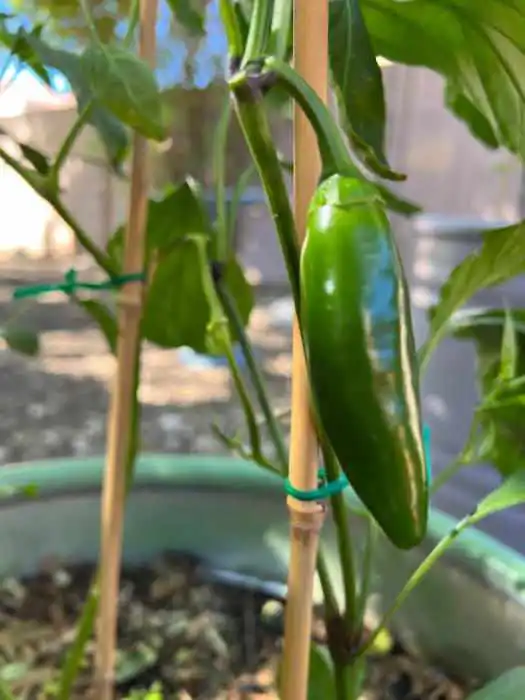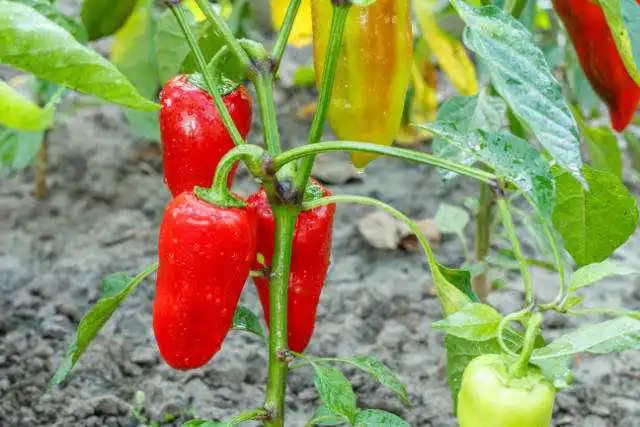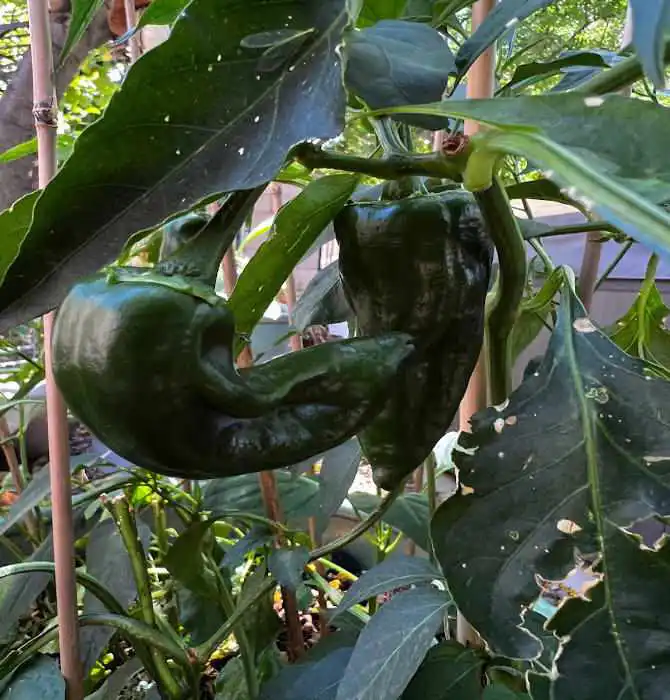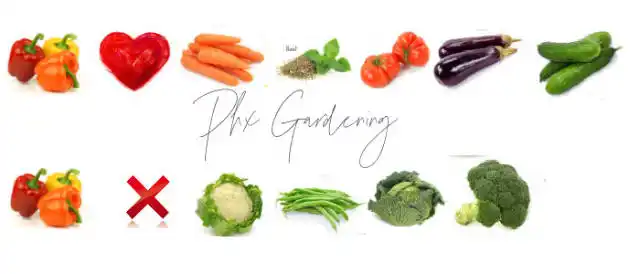Peppers are such a colorful vegetable ranging in color from green, red, orange, yellow, and even purple. With hundreds of varieties to choose from you can pick from sweet mild tasting peppers to fiercely hot peppers.
Peppers are a perfect addition to just about any dish. Below are some popular peppers you can easily grow in your Phoenix garden.
This post may contain affiliate links. Please read our disclosure policies.
Grow Peppers in Your Home Garden
- How Pepper Heat is Measured
- 10 Popular varieties of Peppers to Grow
- Sweet Peppers to Grow
- Mild & Medium Peppers to Grow
- Hot & Extremely Hot Peppers to Grow
- When & how to plant peppers
- What do peppers need to grow?
- What grows well near peppers and what doesn’t?
- Do your peppers look unhealthy? What could this mean?
- Harvesting peppers- When is the ideal time to pick peppers?
Scoville Scale: Pepper Heat
Peppers can range from sweet mild flavors to hot and extremely hot. The Scoville Scale is a measurement tool used since the early 1900’s to measure the heat or spiciness of peppers. It measures the capsaicin content, which is compound responsible for the spicy sensation.
The Scale classifies peppers by their Scoville Heat Units (SHU) ranges: sweet peppers usually have no detectable spiciness so they have a SHU of 0. Mild peppers have a touch of spiciness or up to 2,500 SHU. If you’re looking for a moderate level of heat for your salsa or nachos you’ll probably reach for a medium pepper with a SHU between 2,500 – 30,000 SHU.
Add a substantial kick to your dish with hot peppers in the range of 30,000 – 100,000 SHU. Very hot or extremely hot peppers are over 100,000 SHU. Use caution when adding these peppers to your dishes.
10 Pepper Varieties to Grow in Your Phoenix Garden
If you’re looking for a variety of color and spice the following peppers range from mild to hot and our perfect for your Phoenix garden.
- Bell Pepper
- Jalapeño
- Poblano
- Serrano
- Habanero
- Banana
- Anaheim
- Pepperoncini
- Purple Beauty
- Shishito
Sweet Peppers to Grow
- Banana
- Bell
- Corno di Toro
- Cubanelle
- Marconi
- Pepperoncini
- Pimiento
- Shishito
Mild & Medium Heat Peppers to Grow
Hot & Extremely Hot Peppers to Grow
What I am currently growing
I am currently growing bell, jalapeño, poblano, and banana peppers in our home garden.

When to Plant Peppers
Peppers are a warm-season vegetable. They prefer a soil temperature of 75 degrees Fahrenheit.
Transplant peppers in February, March, and July in your Phoenix or zone 9b garden. If you stagger planting, provide shade in the intense summer sun, and protection from frost you can grow peppers just about year round in Phoenix. Peppers are hardy in growing zones 4-10.
What Peppers Need to Grow
Light Requirements: Peppers prefer full sun or about 6 -8 hours of sun a day, however they can tolerate partial shade.
Soil Requirements: Prefers heavier, well-drained soil, but peppers can also grow well in amended clay or sandy soils as well. Peppers prefer slightly acidic pH. The soil pH range of 6-7 is ideal.
Water Requirements: Peppers like consistent moisture.
Planting Peppers
Sow seeds 1/4″ deep. Allow 12-24 inches of space between plants. Seedlings will start to emerge in 10-21 days. Peppers need a long growing season, so it is recommended to start pepper plants indoors in December or 8-10 weeks before the last frost.
Transplant the seedlings outdoors when the soil temperature is consistently above 60°F. In Phoenix, transplants can be planted outside after the last week in February.
If growing in a container choose a pot that is at least five gallons in size. Make sure to provide adequate support, as the plants can become top-heavy with fruit.
Sweet Peppers
Popular dishes for sweet peppers includes: salads, salsa, sauces, stir fry, stuffed peppers, grilled & roasted or in sandwiches for a delectable crunch.
The most popular sweet pepper is the Bell pepper. You can find them in green, red, yellow and orange. Each color has a slightly different flavor. They are great for salads and sandwiches. California Wonder is a popular variety to stuff. You can also find purple and chocolate bell pepper varieties.

Heirloom “California Wonder” Pepper Vegetable Seeds – Sweet Bell PepperHands down, Cali… [More]

Grow Heirloom Peppers – Plant Purple Beauty or Purple Bell Pepper Seeds – Sweet Bell Pe… [More]
Pepperoncini Peppers are mild and slightly sweet and often added to salads. They are a popular Italian frying pepper. Long and slender, these peppers are great for frying, grilling, and sautéing.
You’re probably familiar with pimento peppers as they are often stuffed in green olives. These sweet peppers are green and mature to a dark red color. Size: 4.5″ length at maturity.
Cubanelle peppers are often used in Latin American and Mediterranean cuisine. They are great for frying or stuffing. Size: Peppers are usually 6″ long at maturity. Color: light yellow to green, if left to mature they turn red. Heat Level: 500-1,000 SHU.
Tangy-sweet banana peppers are great for pickling. We like to add them to sandwiches and wraps.
Corno di Toro peppers are large, fruity flavored, horn-shaped peppers available in red and yellow varieties often roasted or grilled.
Mild to Medium Heat Peppers
A perfect balance between flavor and spiciness, medium heat peppers enhance the flavors of some popular dishes such as chili, salsa, pico de gallo, stir fry, salsa verde, and enchiladas. Some common medium heat peppers include:
Anaheim peppers are mildly spicy and commonly used in Mexican and Southwestern cuisine. They are great for making salsas, chiles rellenos, and sauces. Heat level: 500-2500 SHU.
Güero peppers are yellow chili peppers that are often pickled or used in traditional dishes like chiles toreados. Heat level: 5,000-8,000 SHU.
Fresno peppers have a slightly sweeter flavor than jalapeños. They are great for making hot sauces, and pickles. Heat level: 2,500-10,000 SHU.
Jalapeño peppers can range in heat. They’re used in everything from pickled jalepenos, in salsas, nachos and more. Heat level: 2,500-8,000 SHU.
Poblano peppers are one of our favorite peppers to cook with. The pepper has a mild to medium heat and it often used for stuffing or making dishes like rajas con crema. Heat level: 1,000-1,500

Grow heirloom peppers – Ancho or Poblano Pepper Seeds – 1, 000-2, 000 ScovillesThis hea… [More]

Grow open-pollinated peppers – Jalapeno TAM Pepper Seeds – 1, 000-1, 500 ScovillesAs it… [More]
Serrano peppers are often used in pico de gallo, and hot sauces. Heat level: 10,000-25,000 SHU. Size: Fruit is 3 to 4 inches at maturity.
Hot & Extremely Hot Peppers
Hot peppers can add a serious kick to your dish. Use sparingly and use caution when adding these peppers to your dishes or sauces.
Habaneros are known for their intense heat and fruity flavor. These type of peppers are commonly used in salsas, and marinades. Personally we love to add habanero infused vodka or tequila to a fruity drink. It adds a really good kick.
Thai chili peppers are tiny spicy peppers used to create green and red curry and used in dipping sauces.
Ghost Peppers, or Bhut Jolokia are another incredibly hot pepper. Use sparingly.
One of the world’s hottest peppers, is the Carolina Reaper. It’s primarily used for hot sauces.
Companion Plants for Peppers
Peppers are part of the Solanaceae family, so they like plants in their family such as tomato plants. Basil, carrots, oregano, cucumber, eggplants, and squash are also great companion plants for peppers.
Do not plant peppers near beans, broccoli, cauliflower or cabbage.
When to Harvest Peppers in Phoenix
Depending on the variety of peppers they take 60- 100 days from the day of planting until harvest day. If transplanted in February they would be ready to harvest by May. Peppers planted in July would be ready to harvest by October.
Depending on the variety of pepper at maturity the plants can have a spread of at least 12 inches and a height maturity up to 48 inches. Fruit is about 3-5 inches.






